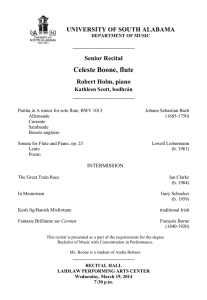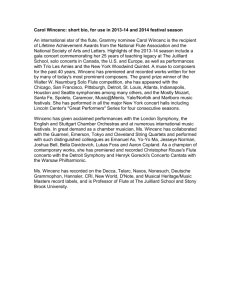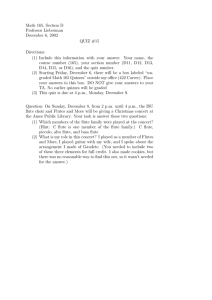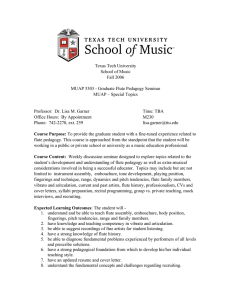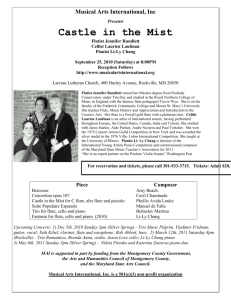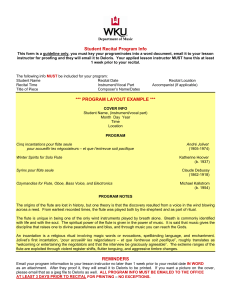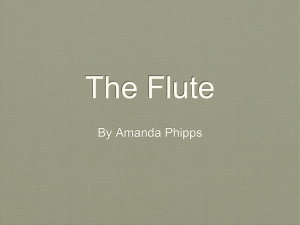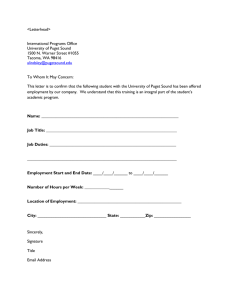WHITNEY REVEYRAND ’15, FLUTE SENIOR RECITAL SCHOOL OF MUSIC
advertisement
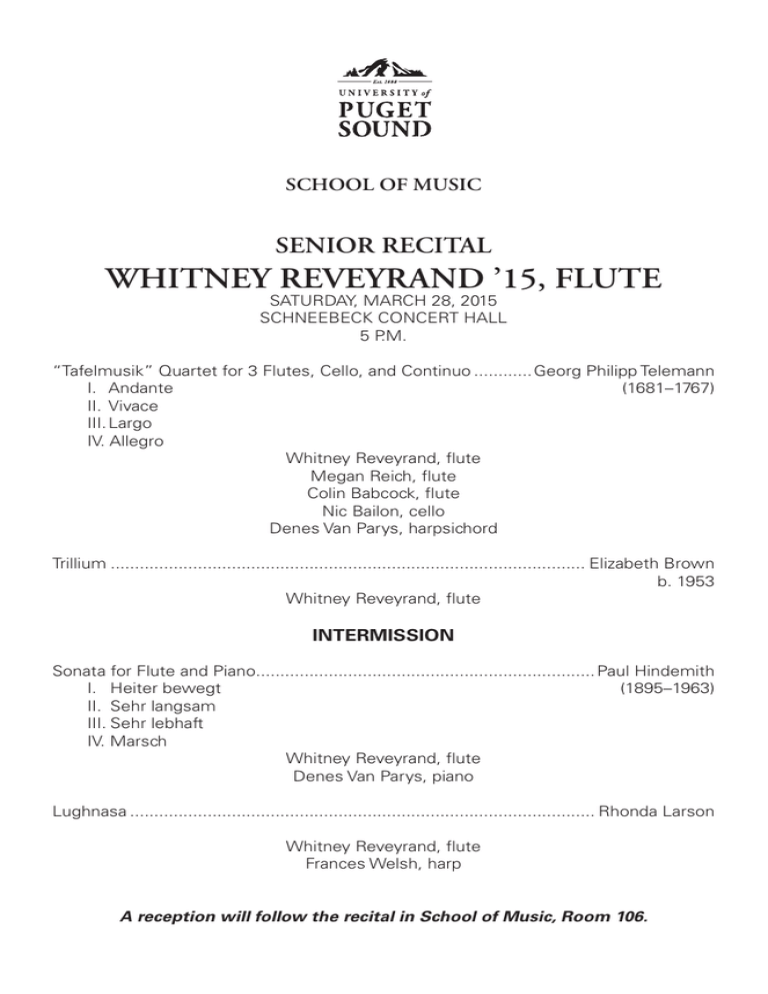
SCHOOL OF MUSIC SENIOR RECITAL WHITNEY REVEYRAND ’15, FLUTE SATURDAY, MARCH 28, 2015 SCHNEEBECK CONCERT HALL 5 P.M. “Tafelmusik” Quartet for 3 Flutes, Cello, and Continuo.............Georg Philipp Telemann I. Andante (1681–1767) II.Vivace III.Largo IV. Allegro Whitney Reveyrand, flute Megan Reich, flute Colin Babcock, flute Nic Bailon, cello Denes Van Parys, harpsichord Trillium................................................................................................... Elizabeth Brown b. 1953 Whitney Reveyrand, flute INTERMISSION Sonata for Flute and Piano....................................................................... Paul Hindemith I. Heiter bewegt (1895–1963) II. Sehr langsam III.Sehr lebhaft IV. Marsch Whitney Reveyrand, flute Denes Van Parys, piano Lughnasa................................................................................................. Rhonda Larson Whitney Reveyrand, flute Frances Welsh, harp A reception will follow the recital in School of Music, Room 106. PERFORMER WHITNEY REVEYRAND ’15 is majoring in flute performance with a minor in business. She studies flute with Karla Flygare. Whitney currently plays principal flute and piccolo in the Symphony Orchestra, co-principal flute in the Wind Ensemble, and is a member of the Flute Ensemble, and various other chamber groups at Puget Sound. Whitney coaches the flute section of the Puget Sound Youth Wind Ensemble each week. Additionally she maintained a staff position for Foothill High School Marching Band in Henderson, Nev., where she worked as a flute specialist and marching technician since 2011. Whitney has served as the editor for the Beta Delta chapter of Sigma Alpha Iota since fall 2012. GUEST PERFORMERS Megan Reich ’17, student of Karla Flygare, is double-majoring in flute performance and natural science. Colin Babcock ’18, student of Karla Flygare, is majoring in flute performance. Nic Bailon ’18, student of David Requiro and Meta Weiss, is majoring in music. Frances Welsh ’17, student of Pat Wooster, is double-majoring in music and cellular and molecular biology. PIANIST DENES VAN PARYS, accompanist, collaborative artist, conductor, and composer, has led performances for numerous international opera companies, theaters, orchestras, and national tours. He received his Bachelor of Music degree in music theory and composition from Washington State University, and pursued graduate studies in opera and musical theater conducting at Ithaca College. He currently is staff accompanist at Puget Sound. ACKNOWLEDGMENTS It is my hope that in putting together this recital, the program and experience would reflect a culmination of my time here at University of Puget Sound. Much like Lewis Carroll’s Alice, my educational experience has been a journey, and the school of music, my Wonderland. Much like the story of Alice, this program presents musical vignettes of which I could not have achieved without the patient guidance of my teacher, Karla Flygare, nor my wonderful musical peers. And to Heather—a sincere thank you. Your kindness helped support me, especially when I felt utterly lost. Take my hand, and let’s all venture down the rabbit hole together. PROGRAM NOTES by Whitney Reveyrand Quartet for 3 Flutes, Cello, and Continuo As a German Baroque composer, Georg Philipp Telemann can be considered to be one of the most prolific composers of his time. This trio has the name “Tafelmusik,” which means table music, a reference to music meant to accompany meals. Although this work was originally intended for recorder and transverse flute, we are performing this work on the contemporary flute accompanied by the cello and harpsichord. Each instrument brings its own unique color to the texture, which is an advantage to playing with both the cello and harpsichord. This work is spectacular in presenting an array of characters, colors, and styles of music and proves to be a fantastic addition to the diversity of this program! Trillium Commissioned by the National Flute Association for the high school division competition in 2000, this work plays with the many timbres a flute can produce. Elizabeth Brown incorporates multi-phonics, which allow the flute to play two notes at once, over-blown trills to evoke the sound of birds flying away, and many more nontraditional flute fingers to create a blossoming sound. This piece follows a three-part ABA form which reflect the three petals that distinguish the flower (trillium) described in the piece. Beyond the musical content contained within the work, this piece stirs a dear memory for me. I discovered it in a bin at the National Flute Association Annual Convention in 2010. Up until that point, I had only heard the word “trillium” in one other context. As a child, I would spend my summers with my papa in Michigan. We would take long walks through the woods surrounding his house, and as we sat on a moss-laden log, he would show me the trilliums as they scattered through the gully. It became a game, and to this day, we still play to see who can say the word “trillium” fastest. Sonata for Flute and Piano This work by Paul Hindemith has become a standard within the flute repertoire. Composed within a time of fear and censorship, Hindemith wrote this piece during his time teaching at Berlin Hochschule for his colleague, flutist, Gustav Scheck. The work could not be premiered, however, because by the time it was written and ready for premiere, the Nazi regime had forbidden the performing of any of Hindemith's works on the grounds that his music represented ”cultural Bolshevism.” I think that the audience will find this piece very bold in character with moments of repose. Throughout the work there are moments of rebellious triplets slotted in the midst of phrase with duple rhythms. In the third movement, when the theme centers around rhythmic triplets, Hindemith places 16th notes, demonstrating musical defiance of meter. It is my hope that the audience is taken on a journey through the melodydriven first movement, expansive musicality in the second movement, lilting character-driven third movement, and the rigid march of the fourth movement. Lughnasa Pronounced Loo-ness-uh, this work is a light fun way to end a program. In Celtic mythology, a Lughnasa was a feast at harvest time to celebrate abundance, and appropriately, you will find this piece surely has an abundance of notes. Rhonda Larson explains that she wanted to create a fiddle-like quality and found her inspiration through J.S. Bach’s Violin Prelude No. 12. The Celtic feel revealed itself as a result of the composition process. In the abundance of notes, the flute actually accompanies itself, which allows for a diversity in the interpretation of this piece. This work may be performed as a flute alone work, or with the added in colors of harp and percussion. Ultimately, Lughnasa is a piece of celebration! UPCOMING ARTS AND LECTURES Information: 253.879.3555 | pugetsound.edu/calendar Puget Sound is committed to being accessible to all people. If you have questions about event accessibility, please contact 253.879.3236, accessibilty@pugetsound.edu, or pugetsound.edu/accessibility All events free unless noted otherwise MARCH Through Fri., May 15 Collins Memorial Library Exhibit: Celebrating Puget Sound Theater. Sun. March 29, 2 p.m. Student Recital: Brenda Miller ’15, piano, Schneebeck Concert Hall. Sun., March 29, 5 p.m. Student Recital: Gavin Tranter ’16, trumpet, Schneebeck Concert Hall. Mon., March 30, 7:30 p.m. Joint Student Recital: Kim Thuman ’16, viola; Emily Doyle ’15, viola, Schneebeck Concert Hall. Tues., March 31, 8 p.m. Guest Lecture: “Create Dangerously,” by Edwidge Danticat, best-selling author and social activist, sponsored by Susan Resneck Pierce Lectures in Public Affairs and the Arts, Schneebeck Concert Hall. Tickets: $20 general; free for PS faculty/staff/student with ID, available at Wheelock Student Center, 253.879.3100, and online at tickets.pugetsound.edu, and at the door. APRIL Through Sat., April 11 Kittredge Gallery Exhibits: Large Gallery: Makoto Fujimura, Small Gallery: Works by Puget Sound students studying in Germany. Wed., April 1, 5 p.m. Master Class by Steve Miahky, violin, Kilworth Memorial Chapel. Wed., April 1, 6 p.m. Author Talk: “Downwind,” by Sarah Alisabeth Fox, folk historian, mother, author, and overeducated waitress, Thompson Hall, Room 175. Thurs., April 2, 7:30 p.m. Performance: Guest Artist Recital by Steve Miahky, violin, with Duane Hulbert, piano, works by Piazolla, Davidovsky, Berio, and Brahms, Schneebeck Concert Hall. Fri., April 10–Sat., April 11, 7:30 p.m. and Sun., April 12, 2 p.m. Performance: Opera Theatre: Le Comte Ory by Rossini, sung in French with English supertitles, Dawn Padula, director, Schneebeck Concert Hall. Tickets: $15 general; $10 seniors, students, military, Puget Sound faculty/staff; $7 Puget Sound students with ID, available at Wheelock Student Center, 253.879.3100, and online at tickets.pugetsound.edu, and at the door. Fri., April 10, 12:05 p.m. Performance: Organ at Noon, Joseph Adam, organist, Kilworth Memorial Chapel. The School of Music at University of Puget Sound is dedicated to training musicians for successful music careers and to the study of music as a liberal art. Known for its diverse and rigorous educational program, personalized attention to students, the stature of its faculty, and the superior achievements in scholarship, musicianship, and solo and ensemble performance, the school maintains the highest professional standards while providing academic and performance opportunities to all university students. Through faculty, student, and guest artist colloquia, workshops, performances, and a vibrant Community Music Department, the School of Music enriches the cultural life of the campus and community. pugetsound.edu/music | Tacoma, Wash. | 253.879.3700 Community Music, a division of the School of Music, welcomes people of all ages and skill levels to be part of our campus community through music. pugetsound.edu/communitymusic | 253.879.3575
